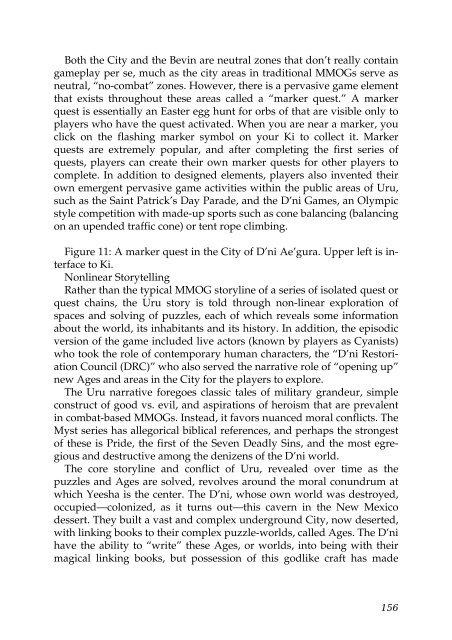Well Played 2.0: Video Games, Value and Meaning - OpenLibra
Well Played 2.0: Video Games, Value and Meaning - OpenLibra
Well Played 2.0: Video Games, Value and Meaning - OpenLibra
Create successful ePaper yourself
Turn your PDF publications into a flip-book with our unique Google optimized e-Paper software.
Both the City <strong>and</strong> the Bevin are neutral zones that don’t really contain<br />
gameplay per se, much as the city areas in traditional MMOGs serve as<br />
neutral, “no-combat” zones. However, there is a pervasive game element<br />
that exists throughout these areas called a “marker quest.” A marker<br />
quest is essentially an Easter egg hunt for orbs of that are visible only to<br />
players who have the quest activated. When you are near a marker, you<br />
click on the flashing marker symbol on your Ki to collect it. Marker<br />
quests are extremely popular, <strong>and</strong> after completing the first series of<br />
quests, players can create their own marker quests for other players to<br />
complete. In addition to designed elements, players also invented their<br />
own emergent pervasive game activities within the public areas of Uru,<br />
such as the Saint Patrick’s Day Parade, <strong>and</strong> the D’ni <strong>Games</strong>, an Olympic<br />
style competition with made-up sports such as cone balancing (balancing<br />
on an upended traffic cone) or tent rope climbing.<br />
Figure 11: A marker quest in the City of D’ni Ae’gura. Upper left is interface<br />
to Ki.<br />
Nonlinear Storytelling<br />
Rather than the typical MMOG storyline of a series of isolated quest or<br />
quest chains, the Uru story is told through non-linear exploration of<br />
spaces <strong>and</strong> solving of puzzles, each of which reveals some information<br />
about the world, its inhabitants <strong>and</strong> its history. In addition, the episodic<br />
version of the game included live actors (known by players as Cyanists)<br />
who took the role of contemporary human characters, the “D’ni Restoriation<br />
Council (DRC)” who also served the narrative role of “opening up”<br />
new Ages <strong>and</strong> areas in the City for the players to explore.<br />
The Uru narrative foregoes classic tales of military gr<strong>and</strong>eur, simple<br />
construct of good vs. evil, <strong>and</strong> aspirations of heroism that are prevalent<br />
in combat-based MMOGs. Instead, it favors nuanced moral conflicts. The<br />
Myst series has allegorical biblical references, <strong>and</strong> perhaps the strongest<br />
of these is Pride, the first of the Seven Deadly Sins, <strong>and</strong> the most egregious<br />
<strong>and</strong> destructive among the denizens of the D’ni world.<br />
The core storyline <strong>and</strong> conflict of Uru, revealed over time as the<br />
puzzles <strong>and</strong> Ages are solved, revolves around the moral conundrum at<br />
which Yeesha is the center. The D’ni, whose own world was destroyed,<br />
occupied—colonized, as it turns out—this cavern in the New Mexico<br />
dessert. They built a vast <strong>and</strong> complex underground City, now deserted,<br />
with linking books to their complex puzzle-worlds, called Ages. The D’ni<br />
have the ability to “write” these Ages, or worlds, into being with their<br />
magical linking books, but possession of this godlike craft has made<br />
156

















